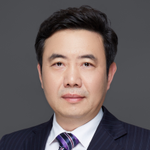- Greetings
Yidong Hu - The Innovation Road of China's Diovasucar Medical Devices
Junbo Ge - Innovation Model of Precision SION Radiotherapy Planning System
Yican Wu - Wearable and Implantable Bioelectronics to Enhance and Recover Vital Functions
Mohamad Sawan - Perspectives on the Influence of AI on Manufacturing
Fawwaz Habbal - Tea Break
- Manufacture and Application of Human Organ Chip
Zhongze GuOrgan chip is a micro artificial organ grown on microfluidic chip combined the technology of stem cell, regenerative medicine, biomaterials, tissue engineering, microfluidic self-assembly application.
The goal of studying organ chip is to simulate the human tissue environment on the chip, carry out the culture of a variety of cells, tissues and organs, reproduce the organ function on the chip. By controlling the biological behavior of cells in the process of in vitro culture, drug screening and evaluation and the construction of disease model through organ chip will promote basic research for basic medicine. This report shed a light on the progress of organ chips in recent years, including the construction of a two-photon / multiphoton organ chip fast and high-precision printing system with independent intellectual property rights, which solves the problem of cross-scale processing of organ chips; More than ten tissues of organ chip models composed of human cells are made by tissue engineering and micro processing technology and means, which solves some key technical problems in drug screening and disease construction. The artificial intelligence system based on deep learning algorithm with the self-developed high-sensitivity biomedical electronic equipment, an automatic instrument that can accomplish accurate detection and measurement of organ chip, which solves the problems of complex operation for observation and analysis in the use of organ chip. Now cooperated with a number of domestic top three hospitals, the screening of accurate tumor drug sensitivity has completed. - Collaborative Innovation Promotes the Ecological Development of the Medical Robot Industry
Weidong ChenThis report will review the development history of medical robot, technical characteristics and challenges of medical robot with the trend of medical robot industry. Bottlenecks and problems existing in the development of technology combine the example of scientific research achievement of transformational medical Robot Research Institute of Shanghai Jiaotong University will be discussed.The speaker will make suggestions on strategies of promoting the development of industrial ecology.
- The Latest Development and Clinical Transformation of Digital Medicine and 3d Printing Technology in the Field of Orthopedics
Jinwu WangAs one of the core leading technologies of scientific and technological revolution, 3D printing is an important technical means to realize the digital transformation of hospitals, which widely used in the field of digital medical application of orthopedics, oncology, stomatology etc. (Including 3D printing rehabilitation aids, surgical guides, surgical models and implants)
Patients have obvious individual body differences, which challenge the conventional treatment .3D printing technology can provide patients with personalized and accurate treatment through digital measurement, which can solve the contradiction between personalized needs and standardized products. Biological 3D printing is a highest level of 3D printing technology and an extremely important new regenerative medicine engineering technology to reconstructs human tissues and organs, involved the processing of active materials with biomaterials, growth factors and cells. - Accelerating the Digital Transformation and High-quality Growth of Emerging Medical Device Manufacturers
Feng Qi一面是市场需求对创新速度的要求不断攀升,一面是法规监管对合规体系的要求日益严苛。这是奥林匹克格言“更高、更快、更强”在医疗器械行业的真实写照。医疗器械企业的运营体系如何能像运动员的运动机能一样,在面对严苛挑战的情形下,仍能保持高度的协调和竞争力?西门子医疗行业端到端的数字孪生解决方案将赋能医疗器械企业,从研发设计、仿真验证到生产制造,打造全方位数字化合规体系的筋骨。
- Stretchable Electronic Skin Under the New Photochemical Technology
Yuqing ZhengElectronic skin is an important development direction of the future electronic industry, which will bring revolutionary changes to the fields of medical diagnosis and treatment, flexible display, intelligent robot and so on. The great gap in mechanical properties between electronic equipment and biological tissue is the main bottleneck in the development of this kind of devices. The unique intrinsic flexibility, solution processability and structural diversity of organic semiconductor materials make them an important direction in the development of this kind of electronic devices. However, at present, the array density of stretchable transistors is only equivalent to the development level of silicon transistors in the 1960s, which greatly limits the application prospect of a new generation of flexible electronic devices that can realize the functions of biological signal reading, processing, and storage in the construction of intelligent electronic systems. The biggest challenge is the lack of high-resolution patterning and integration methods of universal organic electronic materials. For the first time, we realized full direct lithography patterning of organic conductive, semi-conductive and dielectric materials, broke through the key technical barriers that have long restricted the entry of electronic skin into practical industrial production and application, obtained the highest reported density of stretchable transistor array, and integrated more than 10000 transistors in an area smaller than thumbnail. More than 100 times higher than the previous record. This new technology path will change the paradigm in the manufacturing field of flexible electronic devices industry, and finally bring the revolutionary development of wearable electronics industry.
- Advanced Medical Equipment: From "technological Innovation" To "value Creation"
Tianjiao JiangTechnological innovation is the eternal theme of high-end medical devices, such as large-scale imaging equipment, diagnostic equipment, interventional instruments or surgical robot. As innovation of high-end medical devices is emerging, the effort on innovation is evergreen. The final value of the product determines whether the innovation can be sustainable. Unmet clinical needs, better clinical effects and more cost-effective implementation are all ways for technological innovation direct to value creation. We start with the target to the end and judge the trend of medical technology innovation by the perspective of value creation principle.










